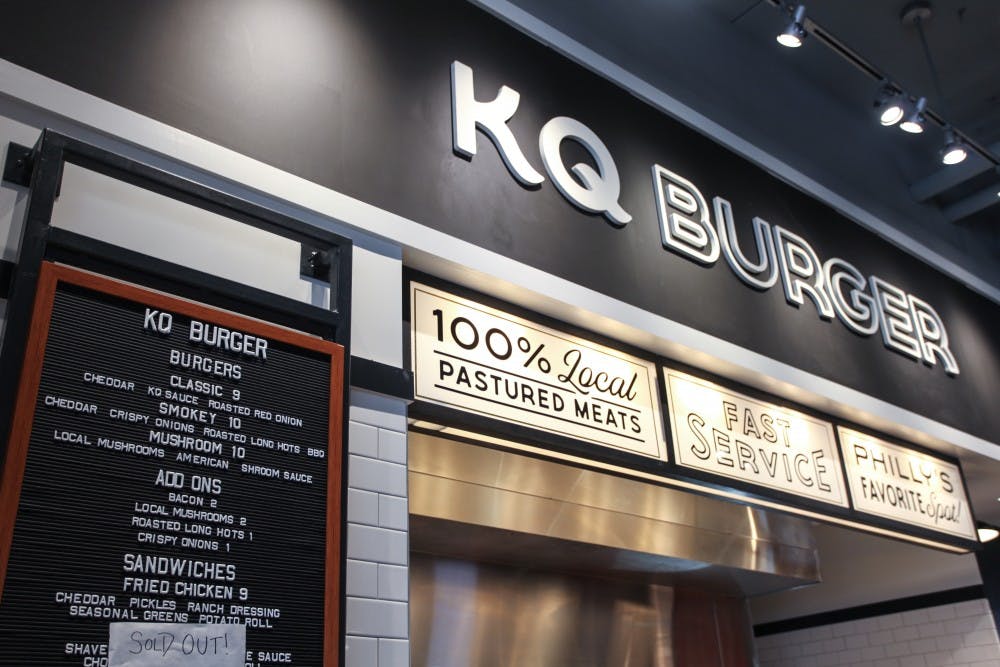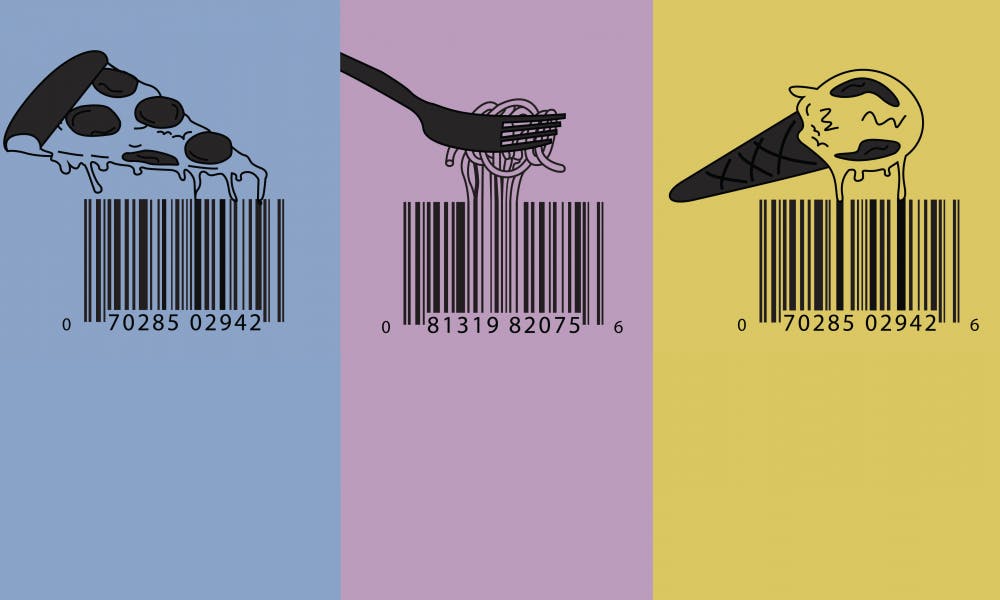“I bought a hamburger, a lousy round hamburger about this size. For nine dollars.” Linda Harris makes a tiny circle with her hands. She emphasizes, “It looked like a McDonald’s hamburger.”
She had recently visited KQ Burger, a vendor in the new Franklin’s Table food court at 34th and Walnut Streets.
Harris has been employed at Penn’s Institute of Contemporary Art for 15 years, working Wednesday to Sunday and commuting via bus from her home in North Philadelphia. She saw Moravian Food Court—whose vendors included Taco Bell, Quiznos, and Nom Nom Ramen—get cut in half in 2008 when CVS moved to 3401 Walnut. And then, she saw it replaced completely by Franklin’s Table Food Hall this year.
“The prices are lousy,” is all she has to say about the most recent manifestation of the 30–year–old food court.
When the food court opened, The Philadelphia Inquirer noted that Franklin’s Table “soars higher” than the Moravian Food Court’s “plebeian choices.” And it’s true: the food court now is home to seven decidedly more upscale options, described as “high–quality, small–format food and beverage operators” in a Penn press release. They represent “local Philly success stories,” according to Ed Datz, Penn’s Executive Director of Real Estate.
But the word “plebeian” has a strong connotation: that the old food court was catering to the wrong clientele, a more common and less affluent one. Harris, who used to frequent the Quiznos in the old food court, represents a population distinctly separate from the one that frequents the new space.

Brooke Behrbaum (E ‘19), a Franklin’s Table regular who stops by once or twice a week, notes that Franklin’s Table “is more tailored toward the student population” than the old food court. Laughing, she adds, “It’s more bougie.”
Maryam Khojasteh, a third–year PhD student in City and Regional Planning at PennDesign, agrees that Franklin’s table seems more exclusive. To her, the court seems to cater “to the undergraduate population here who has disposable income.”
For members of the Penn community not included in that population, whose backgrounds don’t necessarily coincide with the school’s Ivy League image of success and wealth, the food court represents another example of elitism on a campus that’s already difficult to penetrate. The New York Times recently reported that at Penn, more students come “from the top 1 percent of the income scale than from the entire bottom 60 percent.”
“As someone coming from a low–income background, I don’t need to drop $10 per meal to feel satisfied. I don’t need fancy food to feel satisfied,” asserts Lyndsi Burcham (C ‘19). “I literally just need to be satiated.” Lyndsi, a first generation, low–income student who serves on the board of Penn First, finds Franklin’s Table “super isolating for low–income students on a campus that’s already isolating for low–income students.”
The transformation of the food court at 34th and Walnut into the chic, upscale space that Lyndsi finds unwelcoming and exclusive isn’t surprising. It’s part of a larger narrative of the University of Pennsylvania as an entity in West Philadelphia.
“What’s going on with the food court is one little piece of the whole West Philadelphia development plan that the University embraces,” explains Mark Frazier Lloyd, the University Archivist.
Lloyd co–wrote the book Becoming Penn: The Pragmatic American University, detailing how Penn evolved into the university it is today, along with John Puckett, a Professor of Education in Penn’s Graduate School of Education. The two authors cite Judith Rodin’s ten year–long presidency between 1994 and 2004 as transformative in terms of Penn’s relationship to the city. They note that Rodin’s leadership helped put in place “a multipronged strategy called the West Philadelphia Initiatives, which established, finally, a compatible neighborhood for the University.” Penn’s environs seemed dangerous and derelict 25 years ago, and for the administration, that needed to change.
Part of these changes included adding more retail spaces for money–spending Penn students. “We wanted to add more amenities and street vibrancy,” notes Datz. Franklin’s Table reflects a continuation of Penn’s retail strategy, one that embraces the “changing realities” of the consumer market. The Franklin’s Table press release notes that the renovation fits squarely within a “national trend” characterized by transforming “dated” food courts into “dynamic food hall experiences.”

Considering this transformation, Lyndsi accepts that “a lot of students really want that aesthetic.” It’s that image that primarily causes the feelings of isolation that she and other first generation, low–income students feel. “We don’t feel that it’s elitist,” asserts Datz, though. Noting the variety of food options now available in Franklin’s Table, he says, “I think we’ve actually expanded the diversity.”
Anea Moore (C ‘19) isn’t so sure. “They genuinely think the food court is accessible, but it’s not,” she says about Franklin’s Table. “Diversity does not mean accessibility.” Anea, who grew up between Southwest and West Philadelphia, fondly remembers going to the old Moravian Food Court with her mother during the beginning of her time at Penn. “It was a really blended space before.”
Given her background as a Philadelphia native, Anea sees the renovated food court as one piece of Penn’s history in West Philadelphia. Despite growing up so close to campus, Penn’s elite image created an ideological distance. “I can count the number of times I had stepped foot on Penn’s campus in the first 18 years of my life on one hand,” she states. She says that her family and members of her neighborhood also view Penn as “a blocked–off space.”
Her background still affects how she moves through Penn, even though she now calls it home. After hearing about Franklin’s Table’s high prices and exclusive atmosphere from friends, she said to herself: “‘Well, no point in me going there.’”
Franklin’s Table is part of a larger retail web Penn is weaving. Earlier this year, flags appeared on street lamps up and down Walnut advertising ShopPenn, a new branding initiative seeking to consolidate the retail experience around campus. On the ShopPenn website, there’s a listing of nearly every dining establishment on and around Penn’s campus from 34th to 40th Streets. Every vendor housed inside Franklin’s Table is listed along with retailers like Dunkin Donuts, House of Our Own Books, and Saxbys.
Along with a short description of each endorsed establishment, ShopPenn offers insight into prices, providing a scale from one to four dollar signs. All besides Little Baby’s Ice Cream and The Juice Merchant, which have two dollar signs, are labeled with one dollar sign. There’s no price information for DK Sushi.
These seemingly arbitrary price signifiers don’t reflect the reality of all students on campus. “We already have so many high–end options on campus,” states Lyndsi. She cites spaces like Sweetgreen and Honeygrow—dining options that cater toward a largely student clientele. Honeygrow is included on the ShopPenn site, and is granted the lowest possible price rating of one dollar sign out of four.
“There’s like, a socially gratifying feeling going to these places and showing that you can. And because that’s something that the rest of my population doesn’t get to experience,” Lyndsi adds, “it’s just really isolating.”

With 25.9% of its citizens living beneath the poverty line, Philadelphia is the poorest major city in the United States. Any project Penn undertakes that involves its uncertain borders with the larger city is inherently complicated by the contrast between the unimaginably wealthy institution and its city marked by massive wealth disparities.
Lyndsi would generally say that universities are not responsible for carefully crafting themselves to align with their larger settings. She hesitates, and says: “but then, the reason I would say yes with Penn is that they have gentrified and gentrified and gentrified West Philly for years now, and they have explicitly turned it from a place that was filled with predominantly low–income people of color, and have changed it into this hub of one expensive restaurant after another after another that’s not accessible to West Philly residents, nor is it accessible to low–income students who are here.”
“And for that reason I think it is their responsibility,” she affirms.
“Certainly there are a lot of people who are not affiliated with Penn going through 34th and Walnut,” muses Domenic Vitiello, Assistant Professor of City Planning and Urban Studies. He also notes that Penn’s retail is more community–oriented near 40th Street, where campus and the rest of West Philadelphia blend.
Harris also mentions 40th Street when she talks about getting food around Penn’s campus. “You have to go down to 40th Street if you want some real food, Fresh Grocer—they have real food.”
During Harris’ 30–minute lunch break, she does one of three things: walk down 36th Street to Axis Pizza, up the block to Wawa, or down Walnut to the CVS next to Franklin’s Table. Her break is so short that she’s unable to walk to 40th Street and back in time for the “real food” she would ideally buy. She says, “By the time I go down there, my lunch over.”
She adds, laughing, “I can just walk out the door and my lunch over.”
Colin Lodewick is a junior studying English from Woodbridge, Connecticut. He is the Long–Term Features Editor for 34th Street.

